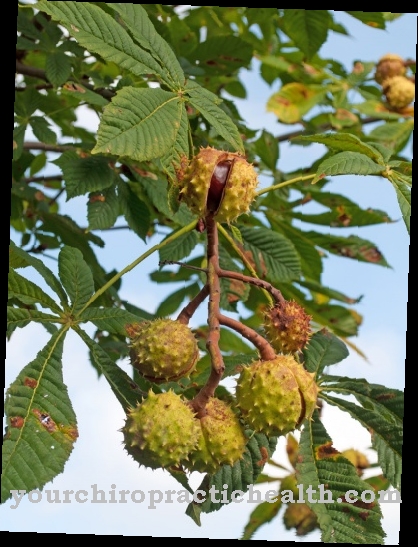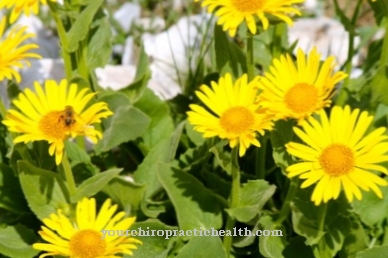The Figwort occurs as early as the 1st century AD in the writings of Dioscorides. In the Middle Ages, the plant was a popular medicinal herb that was mainly used to treat ulcers and swollen cervical lymph nodes. In official phytotherapy, figwort is no longer used today, only occasionally in folk medicine.
Occurrence & cultivation of figwort

The cause of the congenital disease is a weakened lymphatic system, which manifests itself in an increased susceptibility of the skin and mucous membranes. The German plant name is derived from the brown color of the roots and leaves. The perennial plant, which is inconspicuous even in the flowering period, is only noticeable for the unpleasant smell it releases when its leaves are rubbed.
The figwort has a square, straight stem without branches and egg-shaped, stalked leaves that taper to a point. It can be up to one centimeter high. Their panicle-like inflorescences have small, spherical, brownish flowers. The capsule fruits contain many seeds. The figwort blooms from June to August. The herb can then be picked and dried in the shade. If you want to collect the roots, it is best to do so in spring.
It is then carefully cleaned, gently dried and chopped up. The ancient medicinal plant occurs from Europe to East Asia and even in North America. It loves shady locations and moist soils in forests, under hedges and in riparian zones. The other species of figwort are not used as medicinal plants.
Effect & application
The most important ingredients contained in figwort include saponins, flavonoids, iridoids, glycosides (scrofulanin), resins, pectin and organic acids. The plant has a decongestant, immune-boosting, anti-inflammatory, antiseptic, analgesic and slightly diuretic effect. Its roots and leaves are mainly used medicinally. The figwort can be used internally and externally.
When used internally, the patient should limit the remedy cure to a duration of six weeks and then take a treatment break of at least three weeks before continuing the therapy if necessary. Applied internally, figwort tea and diluted tincture are used. For external treatment, tea infusions, tinctures, washes, baths and ointments with figwort are used. The patient can prepare the ointment himself according to a common comfrey recipe.
The tea is made as a cold extract with a teaspoon of dried, crushed roots and a glass of cold water. The mixture must soak in the cold water for at least eight hours before it is strained and drunk in small sips throughout the day. The tea can then be warmed up slightly. It is advisable to take the three-week cure once per season for scrofula.
For normal preparation, 250 milliliters of hot water are poured over a teaspoon of leaves and left to steep for ten minutes. After straining, two cups are drunk daily. To make the figwort tincture, 200 milliliters of vodka are poured over 50 grams of roots in a screw-top jar, closed and kept warm. The tincture must be shaken daily. After four weeks it can be strained and filled into dark bottles.
Tea is used for the compresses, washes and medicinal baths: Depending on the size of the bathtub, a tablespoon of up to 500 grams of figwort leaves are prepared as a cold infusion or warm tea and poured into the hot bath water after straining. The patient should then remain in the hot water for 20 to 30 minutes. Figwort has no side effects when used in the correct dosage. However, patients with heart failure, pregnant and breastfeeding women should not use figwort products.
Importance for health, treatment & prevention
The main areas of application for figwort natural remedies are skin diseases, especially of the face, and diseases of the lymphatic system. These include, for example, eczema of the skin on the face and ears, acne, lichen, neurodermatitis, rash with weeping blisters and minor burns. The compresses can be placed directly on the hard-to-heal, inflamed and ulcerated skin area.
The ingredients reduce the swelling and disinfect the affected skin area. Ulcers on other parts of the body and hemorrhoids can also be treated with a figwort Sitz or full bath. Chronic tonsillitis (angina tonsillaris) is treated by placing eight drops of figwort tincture in a glass of lukewarm water and gargling with it.
The user can also proceed in this way with normal sore throats. Lymph node swelling and allergies are combated with a tea cure. It strengthens the immune system. Edema in the body is also eliminated with figwort tea. The saponins contained in it have a slight diuretic effect. For example, rheumatic complaints are treated in this way.If constipated, the patient puts 3 to 5 drops of the tincture in water and drinks the mixture. In addition, figwort has a slight heart-strengthening effect.
It increases the ability of the heart muscle to contract, reduces its beat frequency and slows down the conduction of excitation. In homeopathy, the preparation Scrophularia nodosa is also used to treat skin diseases, diseases of the lymphatic system, gastrointestinal diseases and general physical weakness. The fresh plant trituration Teep is often used, of which the person concerned takes one or two tablets three times a day.








.jpg)



















